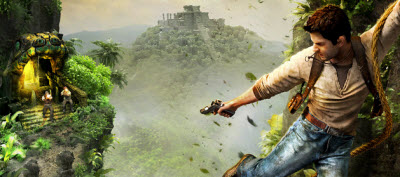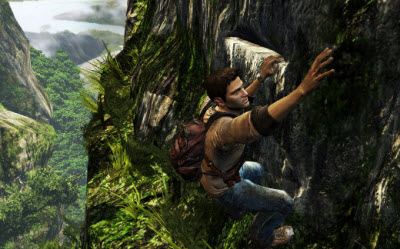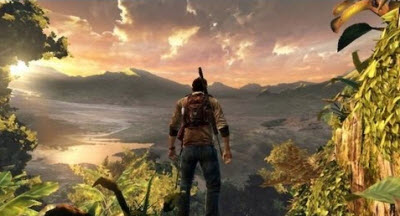 Where’s the wit and good humor?
Where’s the wit and good humor?
The simplistic levels and the not-so-witty dialogue in the early parts of Golden Abyss turned me off, and it made me wonder if Sony had damaged the Uncharted brand that it worked so hard to create and then upgrade over the course of three console games. To me, Uncharted games are beautiful on a number of levels. I have wholly bought into this brand as one of the iconic properties of gaming, mainly on the strength of its storytelling. But I never bought into Golden Abyss or the characters of Dante and Chase as I have with Sully and Elena in the earlier Uncharteds.
The game has 34 chapters, and I played it on normal difficulty over the course of four days for a few hours at a time. It held my attention for most of the eight hours that I played it, though I think the story could have been told in far fewer chapters. It seemed like there was quite a bit of filler meant to satisfy the appetites of those who want to practice their shooting. Some of that is fun, like when you have to hang onto a rope and shoot down at enemies for the first time. But when you do it for the thirtieth time, it gets a little old.
What you really need when you have an adventure this long is some trademark Uncharted humor to break the mounting tension. There isn’t enough of that in Golden Abyss.
The redeeming factor in this game is its 3D graphics and cinematic cutscenes. The visuals are breathtaking at times. You can stand at the top of a pyramid in the jungle and look out upon the landscape of mountains and the sunset.
Bend Studio also created Resistance: Retribution for the PSP. That game rendered 50,000 polygons per frame for the environment. But Golden Abyss uses more than 260,000 polygons per frame. Retribution might have 10 megabytes of textures, while Abyss has 60 megabytes of textures. That translates into much better graphics on the Vita.
But the quality falls short of the console experience. As my daughter pointed out, anything that is shiny seems to be poorly rendered. The landscape and sunsets and terrain all look pretty. But the second you see Drake’s teeth or his eyes, you can see where the graphics suffer. Occasionally, you will see a twinkle in the eyes, but most of the time there is just nothing there. It takes away from the humanity of the characters. Drake’s teeth also look like he has sharpened them so he can look like a piranha.
Some of the water scenes and fire look incredibly well done for a handheld game. A river where you paddle a canoe looks pretty. And so does an underground cavern where you can see the glittering surface of the water. But you’ll also find some graphics flubs. In one part, you have to guide Drake behind a waterfall and emerge on the other side. The falling water looks a little too uniform to be believable. That’s a case where the developer tried to stretch the 3D scenery further than it could go.
The game and its story do get better in the second half. You get better weapons to use in the later levels, including rocket-propelled grenades and Gatling guns. And you get an occasional nice scene, like when Drake and Chase enjoy a moment of solitude in a canoe.
But the story has its weaknesses. I can’t say that it really lives up to the Uncharted series’ standard. When it comes to this franchise, I’m very demanding.
The Uncharted games are known for their set pieces. These are movie-like action scenes that are simply unforgettable. In Uncharted 2: Among Thieves, you get to fight off a helicopter attacking you while you’re in a gun battle inside a building that is falling apart. You have to deal with the same damn helicopter in a firefight aboard a train. In Uncharted 3: Drake’s Deception, you have to fend off enemies while getting sucked out of the open bay of a cargo plane, then continue the fight while you’re in mid-air. You also have to deal with staying ahead of the floodwaters in a capsizing ocean liner in scenes that are reminiscent of the Titanic or the Poseidon Adventure movies.
In Golden Abyss, you won’t find such well-designed set pieces. In one scene, for example, you have to escape a collapsing cavern. But the bad part? You have to fight all the way into the center of this cavern only to turn around and fight your way back out of it as it is collapsing. A lot of ropes magically appear that weren’t there before, so you can expedite your exit by climbing them. But the fact is you are fighting over ground you have already taken.
One of the big missed opportunities is that helicopters actually come into the story on a couple of occasions but just to transport people. Am I the only one who thinks that a helicopter battle, even if one has already appeared in a prior Uncharted game, would have been cool, just to shake things up?
Uncharted: Golden Abyss has a lot of flaws, but it does show off the potential of the PlayStation Vita. It was a disappointing experience in a number of ways, mainly because of poor design choices. But the game got better over time, and it was not so bad that I would quit in disgust. Rather, I became more interested in the story and went on to see it through its ending
If the game had started with the second half and then proceeded to get better from there, I would’ve liked it much more. But as is, the execution of this game is a bit of a setback for the previously unblemished Uncharted brand, and the full potential of the PlayStation Vita is as yet unrealized. For Sony, that’s tough. Developers won’t get good at making games at the Vita for a while, but by the time they do so, Sony’s rivals may eat its lunch. Score: 78/100
Uncharted: Golden Abyss was released for the PlayStation Vita on February 14, 2012. A copy of the game was provided by the publisher for the purpose of the review.


